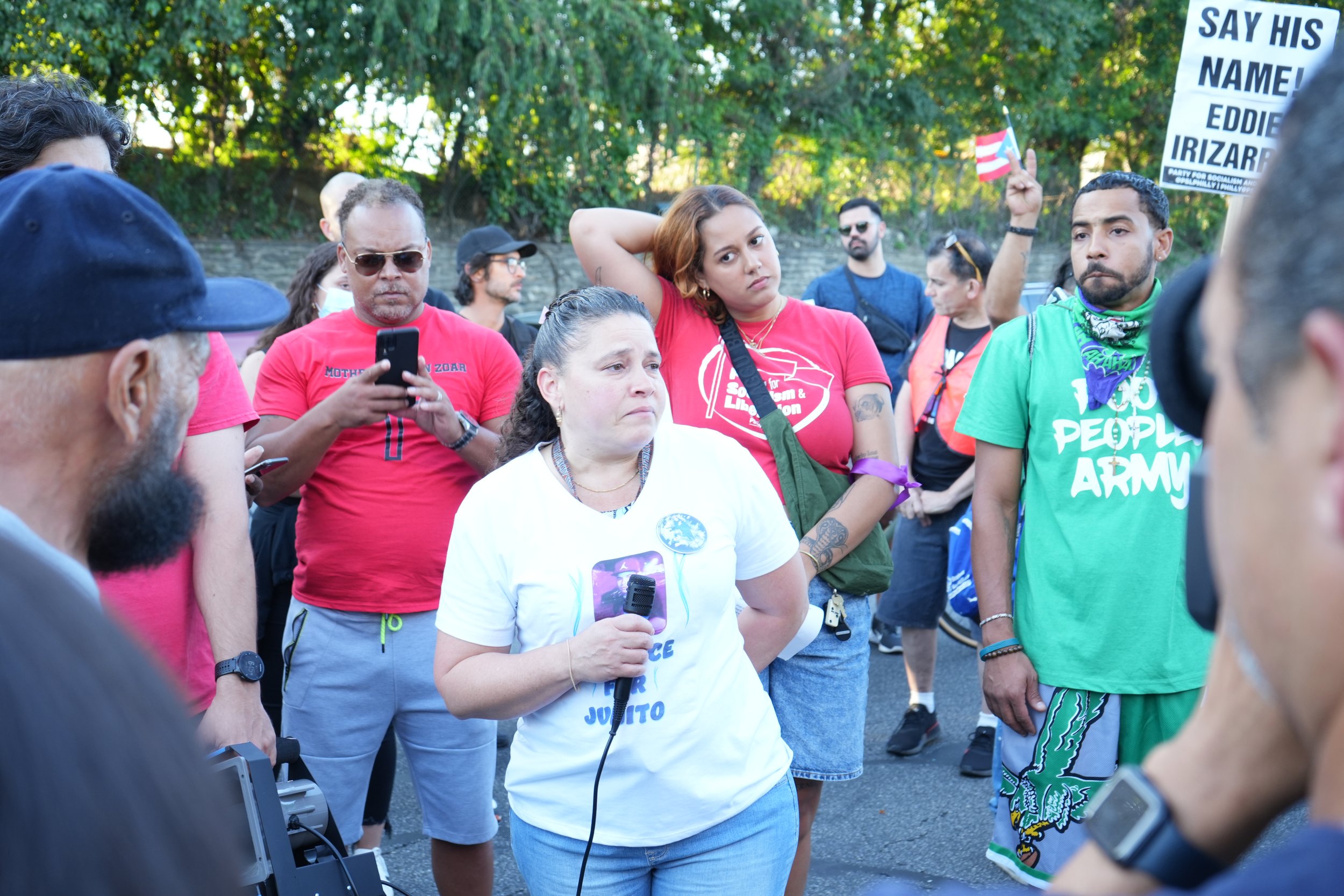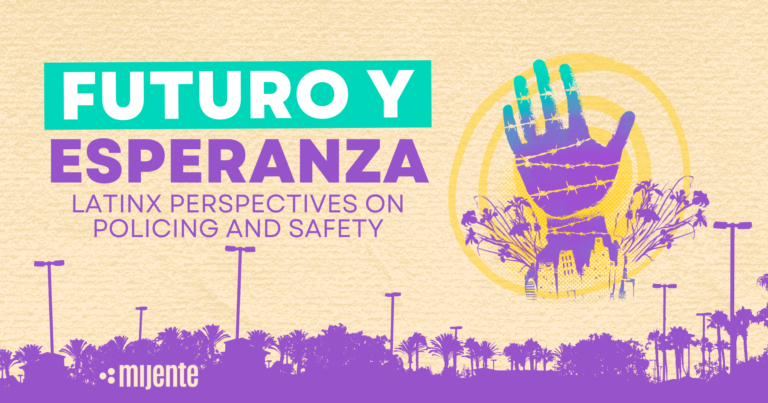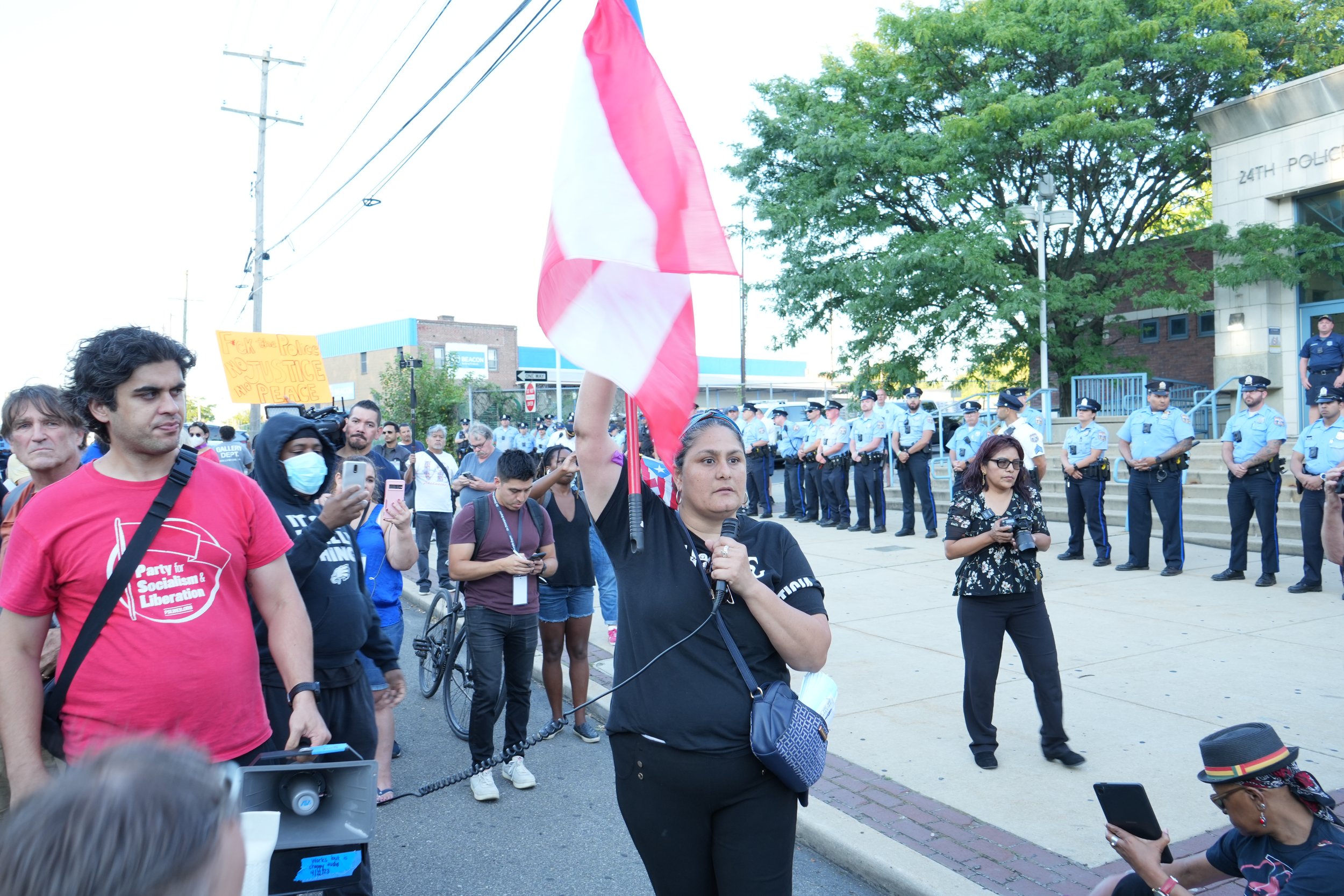Amid slow justice for Eddie Irizarry, Philly’s Latine community confronts its relationship with police
BY NIGEL THOMPSON ON OCTOBER 7, 2023
Alfredo Santiesteban shouted at officers outside the 24th and 25th police district in North Philadelphia at the conclusion of the march on Aug. 31 that demanded the Officer Mark Dial’s body camera footage be released. (Nigel Thompson for ¡Presente! Media)
Philadelphia Municipal Court Judge Wendy L. Pew dismissed all charges against former Police Officer Mark Dial, ruling that prosecutors did not present evidence that he had committed a crime.
This followed a preliminary hearing a week prior, during which Dial was charged for murder — no degree had been announced — and a number of other crimes for the Aug. 14 shooting death of 27-year-old Eddie Irizarry in Kensington. Dial exited his cruiser on the 100 block of E Willard Street after initiating an apparent traffic stop. Within seconds, he shot Irizarry six times through his driver’s side window and windshield, killing him.
Ana Cintron speaking to the 24th/25th District Philadelphia Police (Nigel Thompson for ¡Presente! Media)
Instead, the judge agreed with the officer’s lawyers, who argued that Dial was justified in shooting Irizarry, because he and his partner were reacting to a situation in which they believed their lives were being threatened.
The decision by Judge Pew resulted in a city-wide outrage. That night, protesters and supporters of Irizarry’s family took to the streets and convened at City Hall to march for awareness. The District Attorney’s Office also vowed to appeal the decision, saying it will attempt to refile all charges against Dial.
The PPD’s initial narrative was that Irizarry fled a traffic stop before he pulled over and jumped out of his car with a knife, forcing Dial to shoot him. This account was proven to be false; a lie peddled by Dial’s partner until the bodycam footage was released in its entirety by the Philadelphia District Attorney’s Office on September 8 at the request of Irizarry’s family. Dial also turned himself in that day and District Attorney Larry Krasner announced the charges against him.
When Erika Almirón first saw the footage of Irizarry’s killing, she described it as something that, “you can’t erase from your memory.”
Almirón is a longtime advocate for law enforcement reform in the city, and was once the executive director of Juntos, South Philly-based, Latine immigrant rights advocacy organization. There, she played a pivotal role in pushing the city to eliminate its PARS agreement with ICE. The agreement allowed the PPD to share certain resident information with ICE, which it could then use to carry out deportations, even in cases of no arrest by the police department.
Most recently, Almirón helped organize a community march Aug. 31, demanding the release of Dial’s bodycam footage and for Dial to be charged. She called Irizarry’s family “brave” for wanting to release the full, unedited versions of the bodycam footage because it's yet another snapshot into the PPD’s treatment of their community.
“I believe that they know that it is important for people to see exactly how things play out inside the city of Philadelphia when it comes to police killings, when it comes to how police view our community, view our people,” said Almirón.
Almirón’s organization Mijente has an idea on a national scale. In May of 2022, Mijente released a first-of-its-kind national study into Latine perspectives on policing and safety, delving into first-hand experiences with law enforcement. It was released in response to heightened tensions in 2020, following the prominent police murders of George Floyd and Breonna Taylor, and hoped to clarify where Latines stood on law enforcement.
“Latinos sometimes are taken a little bit as kind of like a pendulum,” said Chio Valerio-Gonzalez, Mijente’s national organizing director. “We can either swing to the right or to the left.”
The study surveyed more than 1,300 Latines nationwide, and as Valerio-Gonzalez pointed out, a large majority of those surveyed (93%) believed that more investment is needed to prevent crime — things like better schools and creating more job opportunities — rather than throwing more police at the issue.
However, the study also revealed a harsh cycle of violence that many Latines experience in their communities on a daily basis, and as a result, a lack of creativity on how to solve the issue.
“It wasn’t that people were against defunding the police, it’s that people couldn’t imagine a society where violent crime was not a fact in their lives,” said Valerio-Gonzalez. “And so therefore, they couldn’t imagine a society without police.”
That also feeds the reality of their complicated relationship with police.
Outside of the Black community, Latines face the second-most incidents of police brutality and killing in the U.S.. Death has especially skyrocketed in the last decade, and researchers warn that rates of fatal incidents could be even higher because not every police department gathers ethnicity data when one occurs.
When considering recent cases on a national scale, Irizarry’s is just the latest of a young Latine dying at the hands of a police officer.
Amid the George Floyd uprisings of 2020, 22-year-old Sean Monterrosa was shot and killed outside of a Walgreens in Vallejo, California by police officer Jarrett Tonn on the night of June 2. The officers were responding to reports of potential looting at the pharmacy.
Charito Morales speaks to officers at the 24th and 25th police district headquarters at the conclusion of the march on Aug. 31 demanding Officer Mark Dial’s bodycam footage be released. (Nigel Thompson for ¡Presente! Media)
Not only were the details kept vague by the Vallejo Police Department for a number of days, but bodycam footage later confirmed that Tonn shot Monterrosa from the passenger seat of his police cruiser, firing through the windshield. The 22-year-old was on his knees with his hands up when he was shot. Tonn allegedly mistook a hammer sticking out of Monterrosa’s pocket for a firearm and began shooting. The windshield Tonn shot through was later destroyed without permission by a city employee, causing the California Attorney General’s office to launch an investigation.
Monterrosa’s killing led to major protests in Vallejo against a police department with a history of violence (and killings) in the city’s communities of color. Tonn was also fired, but he was recently reinstated on Aug. 31, 2023.
In another instance just after Monterrosa’s killing, Andrés Guardado, an 18-year-old Salvadoran-American was killed by a deputy sheriff with the Los Angeles County Sheriff’s Department on June 18, 2020.
What exactly happened is still up for debate to this day. Police say Guardado produced a firearm, forcing officers to shoot him, but witness accounts say the gun was never fired. Multiple autopsy reports since have also indicated that Guardado was shot multiple times in the back by the officer, and potentially while on his knees. Accusations have also arisen that the deputy sheriffs involved in Guardado’s chase and killing were part of a deputy gang that enacted violence in the Compton community.
In the end, Guardado’s family was awarded $8 million by Los Angeles County for his killing.
Back across the country in Philadelphia, Irizarry’s case has many reckoning with the police department’s own fraught history with the Latine community and trying to chart a path forward.
For many in the city’s long standing Puerto Rican community, that fraught history goes back to at least the days of Philadelphia Mayor Frank Rizzo, when police brutalized Black and Brown communities with no consequences.
A more recent incident came during the 2012 Puerto Rican Day Parade in the city, as a police lieutenant punched a woman in the face who he thought had thrown water on him. In 2013, the city settled with 39-year-old Aida Guzman for $75,000, but Josey was never found guilty of any crime, and got his job back with the department.
“We see them as a gang, a ‘blue gang,’ that’s what we call them,” said Charito Morales of how the community views the Philadelphia Police, especially in the 24th and 25th Police District.
In the aftermath of Irizarry’s killing, Morales said it’s like “starting over again” when it comes to building trust. She is a community liaison with the 24th and 25th district, and has helped with a number of events to bridge the gap like back-to-school giveaways, and more.
Councilmember Quetcy Lozada said she wants accountability for all who were responsible in the killing of Eddie Irizarry. Here she is speaking at a recent Puerto Rican flag raising at City Hall. (Courtesy of Jared Piper/ PHLCouncil)
“They tried to get the trust of the community. They tried to show that they are not the bad guys here. They are here to love and support the family,” said Morales. “Great, but now you went 50 steps back with the community because you guys lied.”
Despite the current rift, District 7 City Councilmember Quetcy Lozada still has hope that it can be repaired. That confidence is based on work she said she’s done since 2008 — while Chief of Staff for former Councilmember María Quiñones-Sánchez — of trying to bridge the gap between the police and community.
She said unlike when she started the work, there are captains at the district now that understand what needs to be done to rebuild trust.
“We have captains at the district who all understand community policing,” said Lozada.
The work, she said, has also changed community perspectives about the police.
“I think that even though this incident is a horrible situation, I think it pains people,” Lozada continued. “Because of all the work we’ve done in the past, we have a community that, while they’re angry, while they’re frustrated, while they’re disappointed, they understand that this individual is not a reflection of all of the people who they work with, and who protect and serve them on a daily basis.”
On the campaign trail, Lozada talked at length about her plan to better involve law enforcement and in some cases, bring more, to help solve some of District 7’s issues like violence and the opioid crisis. After Irizarry’s killing and subsequent backlash against law enforcement in her district, she remains steadfast in her approach.
“If you look at my district, and if you know my district, the only way I’m going to bring resolution to many of the issues my district is facing is involving law enforcement,” she said. “True law enforcement, not abusive law enforcement.”
Face-off between 24th/25th Philadelphia Police District and marchers crowd on August 30 (Nigel Thompson for ¡Presente! Media)
In addressing the opioid crisis — one of her district’s most pressing issues — Lozada has suggested leaning on law enforcement to improve the situation. Most recently, the councilmember also used her legislative power to ban safe injection sites from being built in her district, and she was joined by all but one of her fellow district councilmembers. Mayor Jim Kenney vetoed the bill initially, but City Council overrode that decision on Thursday, September 28.
That being said, Lozada was also quick to say that she wasn’t “backing the department,” and stands alongside many in the community in demanding consequences for Dial and anyone else involved in Irizarry’s killing.
“I would like to see everyone held accountable that played a role in the loss of Mr. Irizarry’s life,” she said.







